Who Controls the User Experience? AMD’s Carrizo Thoroughly Tested
by Ian Cutress on February 4, 2016 8:00 AM ESTBenchmark Results: Web and Synthetic
Here are our results from our web and synthetic tests. A reminder of our systems:
| System Overview | |||||
| µArch | APU | Base / Turbo MHz |
Memory | Channel | |
| HP Elitebook 745 G2 | Kaveri | A10 PRO-7350B (19W) | 2100 / 3300 | 8 GB | Dual |
| HP Elitebook 745 G3 | Carrizo | PRO A12-8800B (15W) | 2100 / 3400 | 4 GB | Single |
| Toshiba Satellite E45DW-C4210 |
Carrizo | FX-8800P (15W) | 2100 / 3400 | 8 GB | Single |
| HP Pavilion 17z-g100 |
Carrizo | A10-8700P (15W) | 1800 / 3200 | 8 GB | Single |
| Lenovo Y700 | Carrizo | FX-8800P (15W) | 2100 / 3400 | 16 GB | Single |
Google Octane 2.0
Lots of factors go into web development, including the tools used and the browser those tools play in. One of the common and widely used benchmarks to judge performance is Google Octane, now in version 2.0. To quote: 'The updated Octane 2.0 benchmark includes four new tests to measure new aspects of JavaScript performance, including garbage collection / compiler latency and asm.js-style JavaScript performance.' We run the test six times and take an average of the scores.
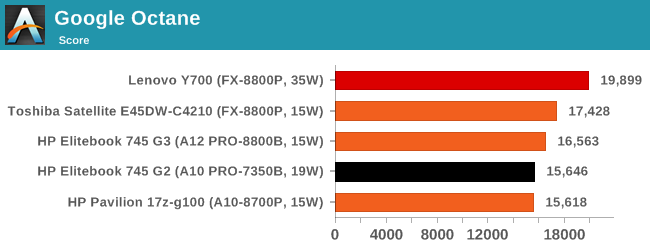
Octane splits hairs between the Kaveri and A10-8700P, but the Toshiba has the higher skin temperature and can turbo for longer than the Elitebook G3.
Mozilla Kraken 1.1
Kraken is a similar tool to Google, focusing on web tools and processing power. Kraken's tools include searching algorithms, audio processing, image filtering, flexible database parsing, and cryptographic routines.
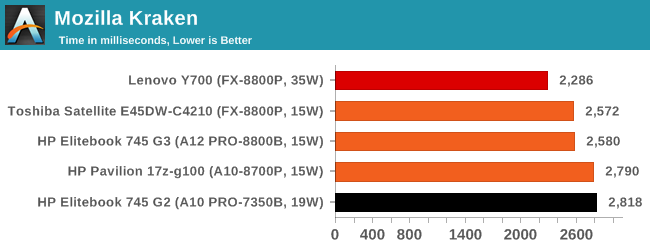
Kraken mirrors Octane, except this time the A10-8700P gets a jump on the Kaveri.
WebXPRT 2013/2015
WebXPRT aims to be a souped up version of Octane and Kraken, using these tools in real time to display data in photograph enhancement, sorting, stock options, local storage manipulation, graphical enterfaces and even filtering algorithms on scientific datasets. We run the 2013 and 2015 versions of the benchmark.
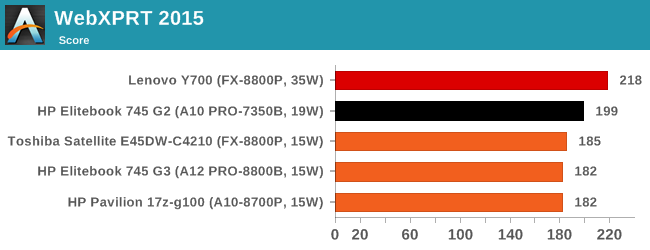
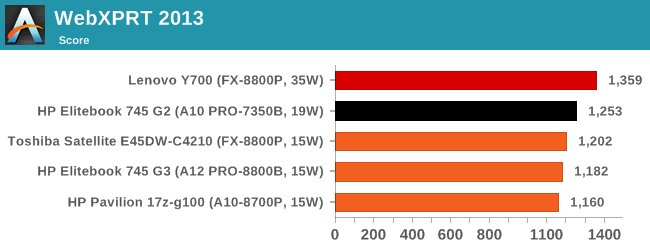
In both versions of the benchmark, the Kaveri system beats all the 15W Carrizo platforms. It was inevitable that at some point during the benchmarking that those extra four watts of thermal headroom in the chip might allow the CPU to turbo for longer – as WebXPRT is by nature a bursty workload, if it can use this to its advantage then we’ll surely see a regression.
I want to pull out some power numbers a little early here to show what I mean. Here are the two Elitebooks in WebXPRT 2013, whose scores differ by 6%:
These power numbers were taken under the ‘all else equal rule’, so each screen was at the same brightness and almost zero applications requesting run time in the background. Here we see that the Carrizo system is drawing less power on average in idle and load (a common theme), but suffers from higher peak power draw and a much larger average-to-idle change in power (which can be overshadowed by onboard components coming out of sleep). It means we get the very uneasy metric of 1208.7 J of energy consumed for the Kaveri over idle and 1932.8 J of energy consumed for Carrizo, though it does depend on how much idle is truly idle across the whole SoC and platform.
This might be where the performance deficit lies though – in a Carrizo system that boasts lower power at idle and lower power draw on average, in a bursty workload environment it is actually wasting time and power to switch things on and off constantly.
Cinebench 15/11.5
Cinebench is a widely known benchmarking tool for measuring performance relative to MAXON's animation software Cinema 4D. Cinebench has been optimized over a decade and focuses on purely CPU horsepower, meaning if there is a discrepancy in pure throughput characteristics, Cinebench is likely to show that discrepancy. Arguably other software doesn't make use of all the tools available, so the real world relevance might purely be academic, but given our large database of data for Cinebench it seems difficult to ignore a small five minute test. We run the modern version 15 in this test, as well as the older 11.5 due to our back data.
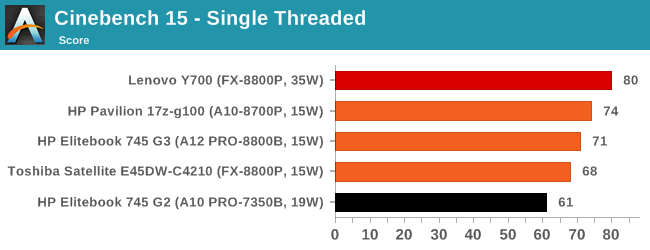

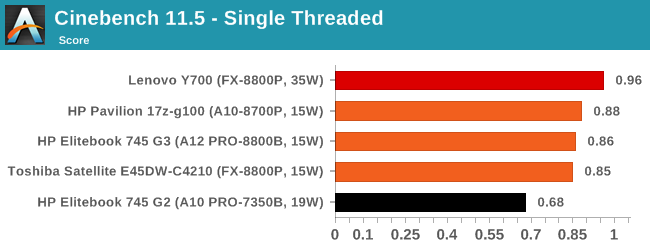
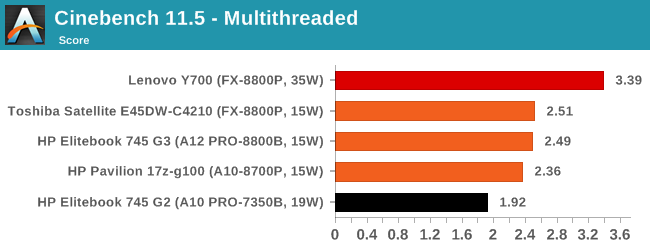
Cinebench shows the spread of performance relating to the microarchitecture advantages of Carrizo compared to Kaveri, as well as the benefits that a 35W part can give over a 15W part. That being said, this spread of results, while perhaps an academic answer to ‘which is the fastest’ is not often seen in the real world.
x264 HD 3.0
The x264 HD 3.0 package we use here is also kept for historic regressional data. The latest version is 5.0.1, and encodes a 1080p video clip into a high quality x264 file. Version 3.0 only performs the same test on a 720p file, and in most circumstances hits its limit on high end processors, but still works well for mainstream and low-end. Also, this version only takes a few minutes, whereas the latest can take over 90 minutes to run.
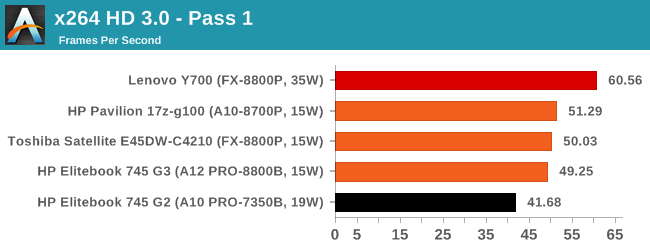
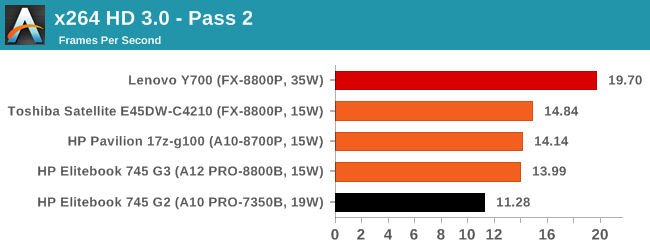
As with Cinebench, we get an ideal academic spread of data.






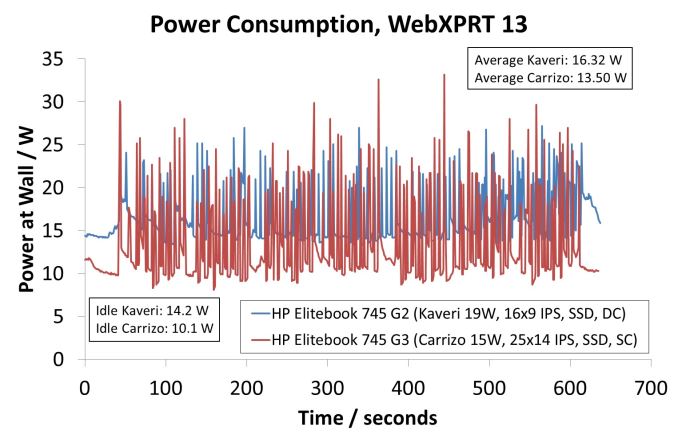








175 Comments
View All Comments
MonkeyPaw - Friday, February 5, 2016 - link
The cat cores exist to compete with Atom-level SOCs. Intel takes the Atom design from phones and tablets all the way up to Celeron and Pentium laptops. It makes some business sense due to low cost chips, but if the OEM puts them in a design and asks too much of the SOC, then there you have a bad experience. Such SOCs should not be found in anything bigger than a $300 11" notebook. For 13" and up, the bigger cores should be employed.michael2k - Friday, February 5, 2016 - link
The cat cores can't compete with Atom level SoC because they don't operate at low enough power levels (ie, 2W to 6W). The cat cores may have been designed to compete with Atom performance and Atom priced parts, but they were poorly suited for mobile designs at launch.Intel999 - Sunday, February 7, 2016 - link
AMD hasn't updated the cat cores in over three years! It is a dead channel to them. They had a bit of a problem competing in the tablet market against a competitor that was willing to dump over $4 billion pushing inferior bay trail chips. Take a plane to China and you can still find a lot of those Bay Trail chips sitting in warehouses as once users had the misfortune of using tablets being run by them the reviews destroyed any chance that those tablets ever had at being sales successes.AMD was forced to stop funding R&D on cat cores as they were in no position to be selling them at negative $5.
In the time that AMD has stopped development on the cat cores Intel has improved their low end offerings, but still not enough to compete with ARM offerings that have improved as well. And now tablets are dropping at similar rates to laptops so it is actually a good thing for AMD that they suspended research on the cat cores. Sorta dodged a bullet.
At least they still get decent volume out of them through Sony and Microsoft gaming platforms.
testbug00 - Friday, February 5, 2016 - link
If the cat cores didn't exist AMD likely would have died as we know it a few years ago.
BillyONeal - Friday, February 5, 2016 - link
The "cat cores" are why AMD is not yet bankrupt; it let them get design wins in the PS4 and XBox One which kept the company afloat.mrdude - Friday, February 5, 2016 - link
YoY Q4 earnings showed a 42% decline in revenue for computing and graphics with less than 2bn in revenue for full-year 2015 and $502m operating loss. You couldn't be more correct. The console wins aren't just keeping the company afloat, they practically define it entirely.Lolimaster - Friday, February 5, 2016 - link
In that case simply remove the OEM's altogether and sell it at AMD's store or selected physical/online stores.TheinsanegamerN - Thursday, February 11, 2016 - link
10/10 would pay for an "AMD" branded laptop that does APUs correctly.Hrobertgar - Friday, February 5, 2016 - link
Since you are talking about use experience, AMD is not the only company with a bad user experience. I purchased an Alienware 15" R2 laptop on cyber Monday and it is horrible, and support is horrible. I compare my user experience to a Commodore 64 using a Cassette drive - its that bad (I suspect you are old enough to appreciate cassette drives). It arrived in a non-bootable configuration. It cannot stream Netflix to my 2005 Sony over an HDMI cable unless I use Chrome - took Netflix help to solve that (I took a cell-phone pic of a single Edge browser straddling the two monitors - the native monitor half streaming video and the Sony half dark after passing over the hdmi cable. It only occurs with Netflix). On 50% of bootups it gives me a memory change error despite even the battery being screwed in. On 10% of bootups it fails to recognize the HDD. Once it refused to shutdown and required holding the power button for 10 secs. Lately it claims the power brick is incompatible on about 10% of bootups. Yes, I downloaded all latest drives, bios, chipset, etc. Customer Service has hanged up on me once, deleted my review once, and repeatedly asked for my service tag after I already gave it to them. Some of the Netflix issue is probably Micorsoft's issue - certainly MS App was an epic fail, but much of even that must be Dell's issue. I realize it is probably difficult to spot many of these things given the timeframe of the testing you do, and the Netflix issue in particular is bizarre. I am starting to think a Lenovo might not be so bad.tynopik - Friday, February 5, 2016 - link
"put of their hands"